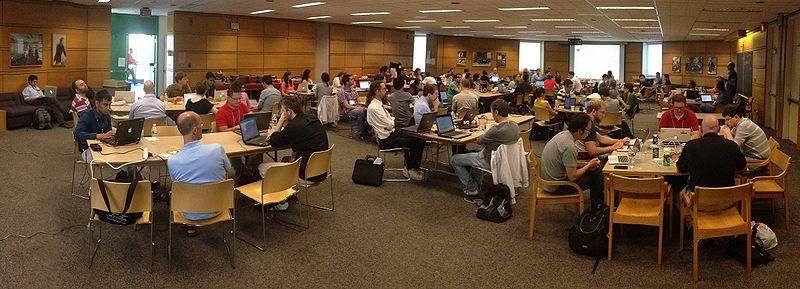Difference between revisions of "NAMIC"
m (Update from Wiki) |
|||
| (17 intermediate revisions by 4 users not shown) | |||
| Line 1: | Line 1: | ||
| − | + | [[image:Projectweek-2014-06-23-IMG 0837.JPG|800px|opening session]] | |
| − | + | Founded in 2005, the National Alliance for Medical Image Computing (NAMIC), was chartered with building a computational infrastructure to support biomedical research as part of the NIH funded [http://www.ncbcs.org/ NCBC] program. The work of this alliance has resulted in important progress in algorithmic research, an open source medical image computing platform [http://www.slicer.org 3D Slicer], built using [http://www.vtk.org VTK], [http://www.itk.org ITK], [http://www.cmake.org CMake], and [http://www.cdash.org CDash], and the creation of a community of algorithm researchers, biomedical scientists and software engineers who are committed to open science. This community meets twice a year in an event called Project Week. | |
| − | + | [[Engineering:Programming_Events|Project Week]] is a semi-annual event which draws 80-120 researchers. The participants work collaboratively on open-science solutions for problems that lie on the interfaces of the fields of computer science, mechanical engineering, biomedical engineering, and medicine. In contrast to conventional conferences and workshops the primary focus of the Project Weeks is to make progress in projects (as opposed to reporting about progress). The objective of the Project Weeks is to provide a venue for this community of medical open source software creators. Project Weeks are open to all, are publicly advertised, and are funded through fees paid by the attendees. Participants are encouraged to stay for the entire event. | |
| − | + | ||
| − | + | Project Week activities: Everyone shows up with a project. Some people are working on the platform. Some people are developing algorithms. Some people are applying the tools to their research problems. We begin the week by introducing projects and connecting teams. We end the week by reporting progress. In addition to the ongoing working sessions, breakout sessions are organized ad-hoc on a variety of special topics. These topics include: discussions of software architecture, presentations of new features and approaches and topics such as Image-Guided Therapy. | |
| − | + | ||
| − | + | Several funded projects use the Project Week as a place to convene and collaborate. These include [http://nac.spl.harvard.edu/ NAC], [http://www.ncigt.org/ NCIGT], [http://qiicr.org/ QIICR], and [http://ocairo.technainstitute.com/open-source-software-platforms-and-databases-for-the-adaptive-process/ OCAIRO]. The next events in this ongoing series will occur in [http://wiki.na-mic.org/Wiki/index.php/2015_Winter_Project_Week Salt Lake City, Utah in January of 2015], followed by one in Boston, MA in June of 2015. | |
| − | |||
| − | |||
| − | |||
| − | |||
| − | |||
| − | |||
| − | |||
| − | |||
| − | |||
| − | |||
| − | |||
| − | |||
| − | |||
Latest revision as of 18:35, 21 November 2014
Home < NAMICFounded in 2005, the National Alliance for Medical Image Computing (NAMIC), was chartered with building a computational infrastructure to support biomedical research as part of the NIH funded NCBC program. The work of this alliance has resulted in important progress in algorithmic research, an open source medical image computing platform 3D Slicer, built using VTK, ITK, CMake, and CDash, and the creation of a community of algorithm researchers, biomedical scientists and software engineers who are committed to open science. This community meets twice a year in an event called Project Week.
Project Week is a semi-annual event which draws 80-120 researchers. The participants work collaboratively on open-science solutions for problems that lie on the interfaces of the fields of computer science, mechanical engineering, biomedical engineering, and medicine. In contrast to conventional conferences and workshops the primary focus of the Project Weeks is to make progress in projects (as opposed to reporting about progress). The objective of the Project Weeks is to provide a venue for this community of medical open source software creators. Project Weeks are open to all, are publicly advertised, and are funded through fees paid by the attendees. Participants are encouraged to stay for the entire event.
Project Week activities: Everyone shows up with a project. Some people are working on the platform. Some people are developing algorithms. Some people are applying the tools to their research problems. We begin the week by introducing projects and connecting teams. We end the week by reporting progress. In addition to the ongoing working sessions, breakout sessions are organized ad-hoc on a variety of special topics. These topics include: discussions of software architecture, presentations of new features and approaches and topics such as Image-Guided Therapy.
Several funded projects use the Project Week as a place to convene and collaborate. These include NAC, NCIGT, QIICR, and OCAIRO. The next events in this ongoing series will occur in Salt Lake City, Utah in January of 2015, followed by one in Boston, MA in June of 2015.
